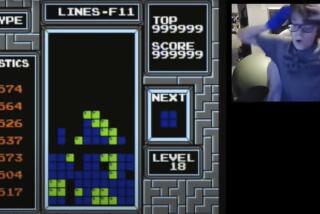Staying in Character
- Share via
Many gamers know Spyro the Dragon and Crash Bandicoot. Chances are, however, they don’t know Mark Cerny, a key figure in turning these characters into the video game equivalent of Bugs Bunny and Daffy Duck.
But don’t call him the creator of Crash and Spyro. Cerny, 36, will wince and say that as producer and designer of games based on these characters, he was merely part of a small band of U.S. developers honing the craft of character-based adventure games.
For the record:
12:00 a.m. Aug. 30, 2001 For the Record
Los Angeles Times Thursday August 30, 2001 Home Edition Tech Times Part T Page 8 Financial Desk 3 inches; 73 words Type of Material: Correction
Game producer--A caption in the Aug. 23 edition of Tech Times incorrectly identified Mark Cerny, president of Cerny Games and former president of Universal Interactive Studios, as the person who created video game characters such as Spyro the Dragon and Crash Bandicoot. He was the producer and designer of games that featured these characters. Insomniac Games created Spyro and Naughty Dog created Crash. Further, the picture identified as “Crash Badicoot” actually was from a different game, “Crash Team Racing.”
Until Cerny arrived on the scene, Japanese developers ruled the world of character-driven games with Nintendo Corp.’s Mario and Donkey Kong and Sega Corp.’s Sonic the Hedgehog. Cerny, fluent in Japanese, learned many of his tricks from his years at Sega, where he worked with legendary Japanese game designer Yuji Naka to create “Sonic the Hedgehog: 2.”
Cerny got his start at Atari in 1982. It was there at age 19 that he created “Marble Madness,” an arcade game that was voted one of the top 100 games of the millennium by online game publication Gamespot.
After seven years at Sega, Cerny joined Universal Interactive Studios and eventually became its president before leaving in 1998 to form his own consulting company, Cerny Games Inc. in Los Angeles.
These days, Cerny is spreading his magic pixie dust on a top-secret project with Electronic Arts Inc. to help launch the Redwood City game publishing giant into the market of character action games. The console title is rumored to be a modern take on the genre, and as one insider called it, “a ‘Looney Tunes’ for the 21st century.”
Q: How do you create characters that last in people’s imaginations?
It’s how you use the character and how your games grow with their use of the characters. This is the problem that faces Eidos. What do they do with Lara Croft now? They need to do something they haven’t done before.
Some people think the most important thing is to have characters that match what you want players to do. But are hedgehogs fast? Why is Mario a plumber? What is a Bandicoot anyway? The basic rule is you shouldn’t try to do too much with your character. But the things you do, you should do very well. If that character jumps, your player should feel the power of that jump. Where we get into trouble is when we have too many things that a character can do and too many objects that a character can interact with. In “Crash,” we have three custom objects in every level you can interact with. That number was as high as 10 for some of the competing products that sold a fraction of what we sold.
Q: How do you create a successful character action game?
This is a really hard market to go after, particularly because it’s a gestalt. Are your graphics good? Is your music good? Is it exciting? Is your marketing good? It’s a combination of art, technology and game play. Succeeding in character action games means being strong in all areas.
I use a total craftsmanship approach. In “Spyro,” we hand-touched every single polygon, and there were about half a million of them. Every polygon got human attention. That’s a lot of work.
We also used a rules-based construction process for the game. We make a short list of the most important things in the game and we continually review the game based on that list. It’s very trite, but you can have only one No. 1 priority, and it’s important to remember what that is.
Q: What else?
Flow is very important. You place the player in the game, and it has to work for every player. That’s why we came up with dynamic difficulty adjustment, which automatically responds to the player’s abilities. The game will get easier if it senses that the player is having difficulty.
You want to train players in what you expect them to do. Make a chart of everything that players will do, and make sure those things are distributed evenly throughout the game. Every time they’re expected to do that task, make it a little harder.
Q: How do you manage frustration levels for players?
Once you set it up so people can go cleanly through the game, you play-test it. We watch players play and capture it all on video tape. We capture the statistics on memory cards and dump the data on a spreadsheet so we can go back in and analyze the points in the game where people died. We count the number of tries players make. When that number exceeds 100, people will just give up.
In “Crash,” it was just too difficult at first. In the first 15 minutes, there were too many players who died and gave up. We spent six months reviewing how people played the game and modifying it to make it playable. We invented rules on the spot. A level should take 20 minutes. If it’s 45 minutes, it’s too long. In “Crash 2,” we said a level should have 40 challenges and three checkpoints. Defeating an enemy is one challenge. Jumping a pit is another. A checkpoint is the spot you come back to if you die. We had 10 challenges in between checkpoints.
Q: You’re a big proponent of details. Explain why that’s important.
In game design, you have the macro and the micro. The macro is the overarching design, the concept of the game. The micro is the day-to-day decisions that change rapidly. It’s where you introduce craftsmanship. Micro-level design is so neglected in games. We barely have a category to describe it. Usually, we talk about macro concepts. We don’t talk about how we introduce these concepts to the player. We need to do both. It’s all about the detail. In “Crash 2,” I put 90% of the crates you smash and apples you pick up in the game myself. They’re important because they affect the flow.
Q: Is there a difference in how Japanese and Americans develop character action games?
From my perspective, Japanese organizations behind character-based games are very large and hierarchical. What we have in the States is a very loose group of people who are passionate about this genre. We all work on projects that very few people outside of Japan can make. It’s much like a movie paradigm, where there are a few people committed to this genre who all work on projects together, much like independent filmmakers. The same people who worked on “Crash” are now working on “Jak and Daxter.” It’s not hierarchical at all, so it’s more difficult to define.
*
Times staff writer Alex Pham covers the video game industry.






